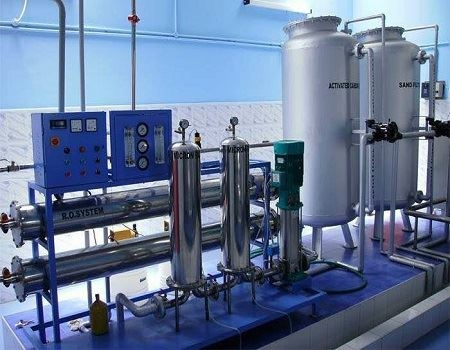Industrial Reverse Osmosis

An Industrial RO (Reverse Osmosis) system is a manufacturing plant which purifies contaminated water through the process of reverse osmosis. The Industrial RO Water plant requires a variety of pre-treatment methods such as softening, dichlorination as well as anti-scalant treatment. After the pre-treatment process, a high level of pressure is used to send water through a semipermeable membrane which retains all the contaminants from the water and passes pure water through. Depending upon the concentration of salts and contaminants in the water, energy levels are determined.
On average, an industrial Reverse Osmosis plant needs 6 kilowatt-hours of electricity to purify 1 cubic metre of water.
RO system helps to purify the contaminated water which can be used for a variety of purposes such as:
- Drinking water
- Desalination
- Wastewater treatment
- Concentration of contaminants
- Reclamation of dissolved minerals, etc.
Reverse Osmosis (RO) is an effective process where you desalinize as well as remove all the impurities by putting it under pressure through a semipermeable membrane which purifies the water.
To thoroughly understand the reverse osmosis process, let first understand the osmosis process:
Osmosis is a natural process where a liquid, such as water, passes through a semipermeable membrane which allows some molecules such as water to pass through, but other molecules such as salts and organic matter are unable to easily pass through the membrane structure.
The flow of liquids through a membrane occurs naturally to even out the salt concentration between the two solutions. Liquid flows from the low concentrated solution, such as freshwater, to a high concentrated solution, such as seawater. When the direction of liquid flow is reversed, it is called reverse osmosis. This process of reverse osmosis is embedded in the Industrial RO plant.
By pressurizing the high concentrated solution, such as seawater, we are able to force water molecules in the reverse direction from the salty seawater side through the semipermeable membrane to the freshwater side.
A semipermeable membrane is often made of cellulose acetate, polymethacrylate and polyamides. We call it a semi-permeable membrane because it allows only the solvent or the water but does not allow the ions, minerals or the colloidal matter present in the water.
An Industrial RO plant contains the following parts:
- Raw water pump
- Activated carbon filter
- Sand filter
- Dosing pump
- Micron Filter
- High-pressure pump
- RO membrane
- Reject line
- Recycling line
- RO product line
- Control Panel Box
